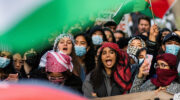Safety Security
Amid slog of Ukraine war, NATO turns warier eye on Russia
| View caption Hide caption
From its founding, NATO has guarded Europe against threats from the east. Those efforts are now being heightened, both for readiness and to deter an unpredictable Russia.
This was a step many member nations wouldn’t entertain prior to Russia’s February 2022 invasion of Ukraine. It was too inflammatory, the thinking went.
Yet today the desire to practice targeting Russia – because of a growing concern that it might one day be necessary – has increased considerably among alliance members.
“We cannot explore and address the shortfalls, the problems, the challenges in exercises if we don’t have real-world geo-data,” says Brig. Gen. Gunnar Bruegner, assistant chief of staff for collective training and exercises at NATO Supreme Allied Headquarters Europe. “It’s as simple as that.”
Next year, NATO will build on this effort by holding its largest live exercise since the Cold War, to include tens of thousands of troops, hundreds of air combat missions, and a trans-Atlantic crossing of U.S. military warships.
The exercises, all told, are a clear indication of the ways in which Russian President Vladimir Putin’s war in Ukraine is transforming how NATO is preparing to fight.
View caption Hide caption
While the war in Ukraine is an unequivocal tragedy, it has forced NATO members to pool resources and prepare for battle in a way they never have – and never were inclined to do – before, a senior NATO military official says: “This is a significant step forward.”
Enough resources to go around?
Officials here say they need to grapple with the reality of competing priorities among alliance members. One example: The war game last month explored what happens when, with battles looming, NATO members choose “to keep something back for their own defense purposes” rather than give it to NATO to use somewhere other than their own backyard, the senior military official notes.
In this way, some members “had to realize that their preparedness, the response that they were able to provide … was not big enough.”
One of the aims of the exercise, after all, was to test, against a “mighty” adversary, how long NATO forces and supplies in different regions will be able hold their lines in an onslaught, and “how best to manage until the reinforcements come,” the official adds.
The war game also illustrates that NATO planners have their eyes on the risk of battlefield catastrophe.
It’s a prudent position. President Putin’s decision earlier this month to pull out of a landmark security pact that had long restricted the use of conventional weapons has raised some alarms among defense analysts.
That came less than a week after Moscow revoked the country’s ratification of the Comprehensive Nuclear-Test-Ban Treaty, which outlaws nuclear weapons tests. Russia then promptly put an intercontinental ballistic missile through its paces.
On the ground in Ukraine, the Kremlin has been replenishing its missile stockpiles considerably more quickly than Western nations had anticipated, according to a recent analysis from the Institute for the Study of War.
“The Russian defense industry is turning out tanks, artillery, munitions 24/7, 365 days a year. And this is not something where NATO has caught up yet,” says Rafael Loss, coordinator for pan-European data projects at the European Council on Foreign Relations.
At the same time, even as they continue to send weapons and military supplies to Ukraine, NATO countries “are investing significantly into rebuilding their forces,” Mr. Loss notes. “And sometimes those two goals are competing.”
Increasingly, the news out of Ukraine seems to indicate that, as the country’s top military commander told The Economist earlier this month, “there will most likely be no deep and beautiful breakthrough” in Kyiv’s current counteroffensive.
In Ukraine, both sides face difficulties
Still, Russia is struggling with the current stalemate in Ukraine as well.
Igor Girkin, a former security agent-turned-ultranationalist critic of Mr. Putin’s conduct of the war – he called it “too kind” – recently lamented that by spring of 2024, Russian forces will be “even less capable of offensive operations than they are now.”
View caption Hide caption
Mr. Girkin, who has also said that Western military aid could allow Ukraine to conduct successful offensive operations in 2024, is now sitting in a Russian jail for his critiques. (Separately, he was convicted in absentia earlier this year by a Dutch court in the 2014 downing of a Malaysian passenger jet over Ukraine.)
In the years before Mr. Putin’s invasion, the expectation among American defense officials was that the Russian military was in very good shape.
In a discussion earlier this month, Lt. Gen. Scott Barrier, a career intelligence officer and now director of the U.S. Defense Intelligence Agency, said the fact that this is not the case has been the biggest surprise of the war.
The agency’s job is to analyze foreign armies. “Having intimate understanding of militaries is really where we’re supposed to be,” he said.
Even so, “our preconceived notions about what the Russian military was turned out not to be true,” Lieutenant General Barrier told an audience at the Center for Strategic and International Studies.
“Honestly, through years of counterterrorism analysis and operations, we kind of took our eye off the ball,” he said.
Still, good military strategists know never to underestimate an adversary. While Russia may be weakened now, it is estimated that Moscow will be able to reconstitute its military “roughly six to 10 years” post-Ukraine, Mr. Loss says. “That is not a very long timeline.”
NATO’s Steadfast Defender exercise early next year is expected to involve roughly 41,000 NATO forces, some 700 air combat missions, the breaching of a Polish river – which NATO officials note is trickier than it sounds – and more than 50 vessels, including the trans-Atlantic crossing of U.S. warships.
The hope is that all this will reinforce NATO admonitions to Russia to stop the aggression.
“Every ship that sails, every aircraft that flies, every tank that rolls,” Brigadier General Bruegner says, “is sending a message.”




